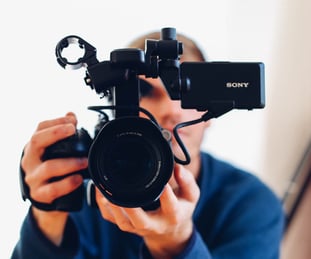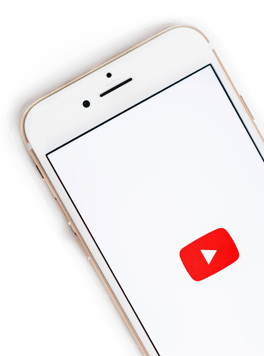 Have you tried using video to market your business? If so you’re not alone.
Have you tried using video to market your business? If so you’re not alone.
The 2020 B2B Content Marketing Benchmarks, Budgets, and Trends—North America study reports:
- 71% of B2B marketers have used video in the last 12 months
- Video is the 5th most popular type of content used among respondents
Whether you’re just getting started with video marketing or you’re looking to better understand how to tweak your current strategy for greater results, this article will help you put all the tasty ingredients together.
You will see that the key to effectively using video for growing your business involves an intentional approach with the right type of video. You must not only understand what types of videos to produce, you must also align them with your marketing funnel, the buyer’s journey, and as you’ll see in a moment, two more essential elements.
“A well-rounded video strategy — one that attracts, educates, converts, and retains your prospects and customers — includes videos that meet different needs across the buyer’s journey.” — Vidyard’s 9 Essential Types of Video for Business
In today’s highly-competitive and noisy marketplace, a purposeful and cohesive video strategy involves a number of essential elements for success. Here’s how to identify and then align them to best meet your goals and your ideal customer’s needs.
Aligning Video Types with Your Funnel and the Buyer’s Journey
There’s a wide range of possibilities to choose from when it comes to video marketing. But what types of video should you create, when and how should you go about using them?
Selecting the right type of video to match your funnel stage goals with the buyer’s journey stage is a good start. Better still is to understand the key aspects of your buyer’s awareness and messaging needs when crafting a holistic strategy.
Think of the following chart as an irresistible video recipe. The left section of your video recipe represents the goals of your funnel stages (Attract, Educate, Convert, Retain), the far-right portion represents the stages of the buyer’s journey (Awareness to Loyalty).
In between, there are three essential ingredients of your video recipe: Video Type, Buyer Awareness, and Messaging.
Think of the video recipe as follows:
- Video type is the right mix of ingredients
- Messaging is the seasoning
- Awareness is the temperature of your buyer to your solution
| Funnel Stage Goals | Primary & Secondary Video | Messaging | Buyer Awareness | Buyer's Journey Stage |
| Attract |
|
Take a more indirect, high-level approach sparking curiosity | Unaware of their problem (cold to lukewarm) to problem-aware (lukewarm to warm) | Awareness |
| Educate |
|
Focus on a formula/system to success; the secret to solving their problem | Becoming more aware of their problem; seeking a solution (warmer) | Awareness & Consideration |
| Convert |
|
Appeal to their emotional hot button with a direct product promise & offer | Solution Aware to Product Aware (warm to hot) | Consideration & Decision |
| Retain |
|
Address your customers’ segment-specific needs/interests | Desires ongoing relationship, support, validation | Loyalty |
| Funnel Stage Goals | Primary & Secondary Video | Messaging |
| Attract |
|
Take a more indirect, high-level approach sparking curiosity |
| Educate |
|
Focus on a formula/system to success; the secret to solving their problem |
| Convert |
|
Appeal to their emotional hot button with a direct product promise & offer |
| Retain |
|
Address your customers’ segment-specific needs/interests |
| Buyer Awareness | Buyer's Journey Stage |
| Unaware of their problem (cold to lukewarm) to problem-aware (lukewarm to warm) | Awareness |
| Becoming more aware of their problem; seeking a solution (warmer) | Awareness & Consideration |
| Solution Aware to Product Aware (warm to hot) | Consideration & Decision |
| Desires ongoing relationship, support, validation | Loyalty |
Here’s a quick summary of the various types of videos named and used in the above diagram:
- Explainer Videos: Short videos designed to attract prospects by providing a high-level look at how your product can address their core problem or need. This fun example uses animation to highlight the importance of measuring video engagement.
- Promo Videos: A quick tease used to hype awareness of your prospect’s problem with a strong call to action promoting a more in-depth, solution-oriented content asset.
- How-To Videos: A step-by-step video designed to teach or educate on how to perform a task or use a product that solves your customer’s problem.
- Live and Recorded Webinars: An educational expert-led online live event that can also be recorded and made available as an on-demand content asset for lead generation and subsequent nurturing.
- Case Study Videos: Also known as customer success stories, these medium-length videos help illustrate how your customers have used your product/service to achieve their goals or solve their problems. Check out this customer success story video of how Vidyard helped a client solve their problem of cutting through the noise.
- Demo Videos: More detailed product demonstration videos serve to explain the practical value of your product and how it works.
- Thought Leadership Videos: Used to share your company’s unique perspective or expertise on a topic building trust and increasing consideration for your product/service.
 Personalized Videos: Polished videos that can be used on your website or in emails that are customized to specific customer segments. These build loyalty and make a personal connection with your customers.
Personalized Videos: Polished videos that can be used on your website or in emails that are customized to specific customer segments. These build loyalty and make a personal connection with your customers.- Culture Videos: Also known as brand videos, culture videos can be used to help build affinity for what you stand for. Think of these as your position statement in the marketplace. See how to make a big impact on brand loyalty and more with culture videos.
Optimizing Your Video Recipe for Maximum Impact
Other factors such as production value, video length, and channel distribution options play into optimizing your video recipes to maximize success.
According to Vidyard, a video platform for business, some videos should be short, scrappy and promoted on social media. Others, however, work best when they’re more lengthy, produced in a polished manner, and placed on owned media such as on your website or your YouTube channel.
Formulating your video recipe strategy together with the optimization factors will make your video marketing execution irresistible to your target audience. Doing so will help you captivate interest and stand out from your competition.
To learn more, we highly recommend Vidyard’s free resource: 9 Essential Types of Video for Business — A Guide to Using Them Throughout the Buyer’s Journey.




